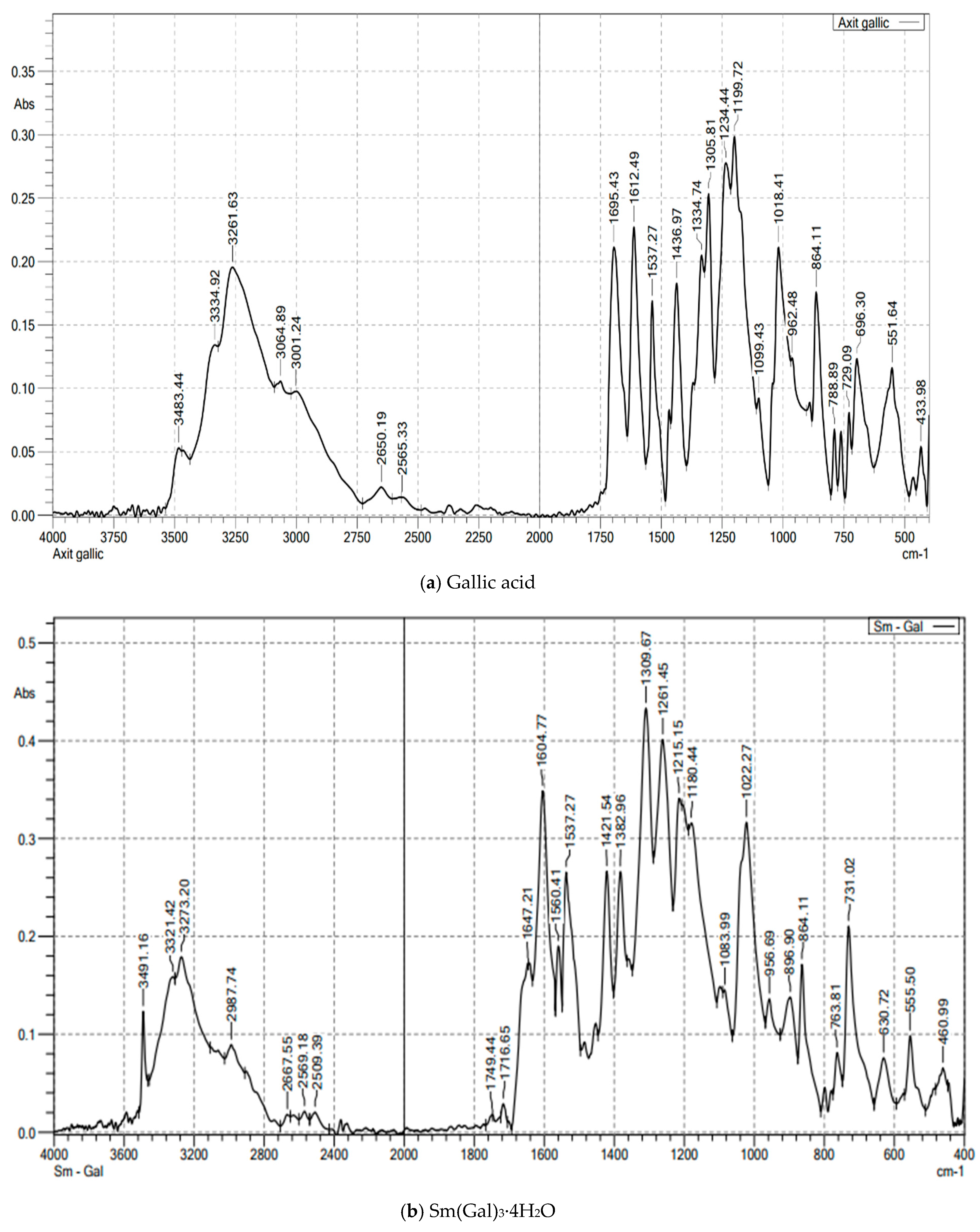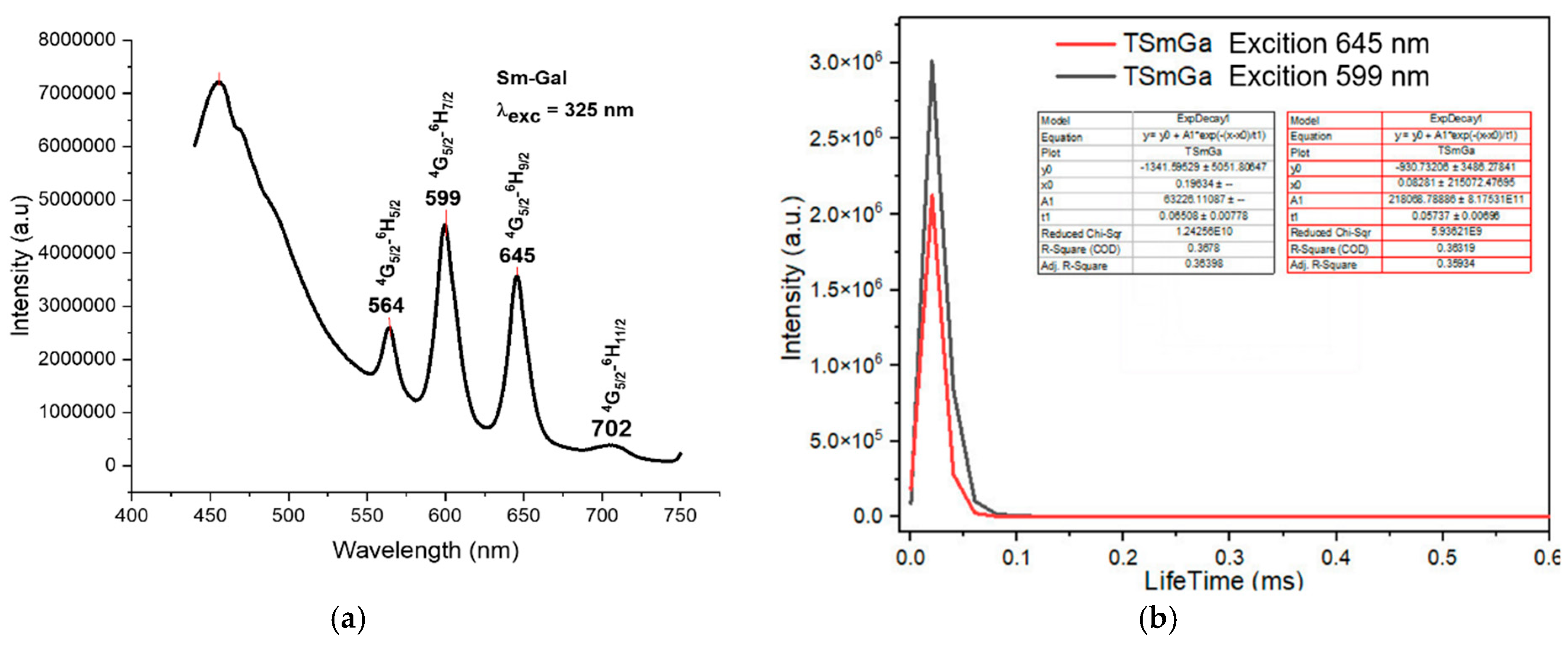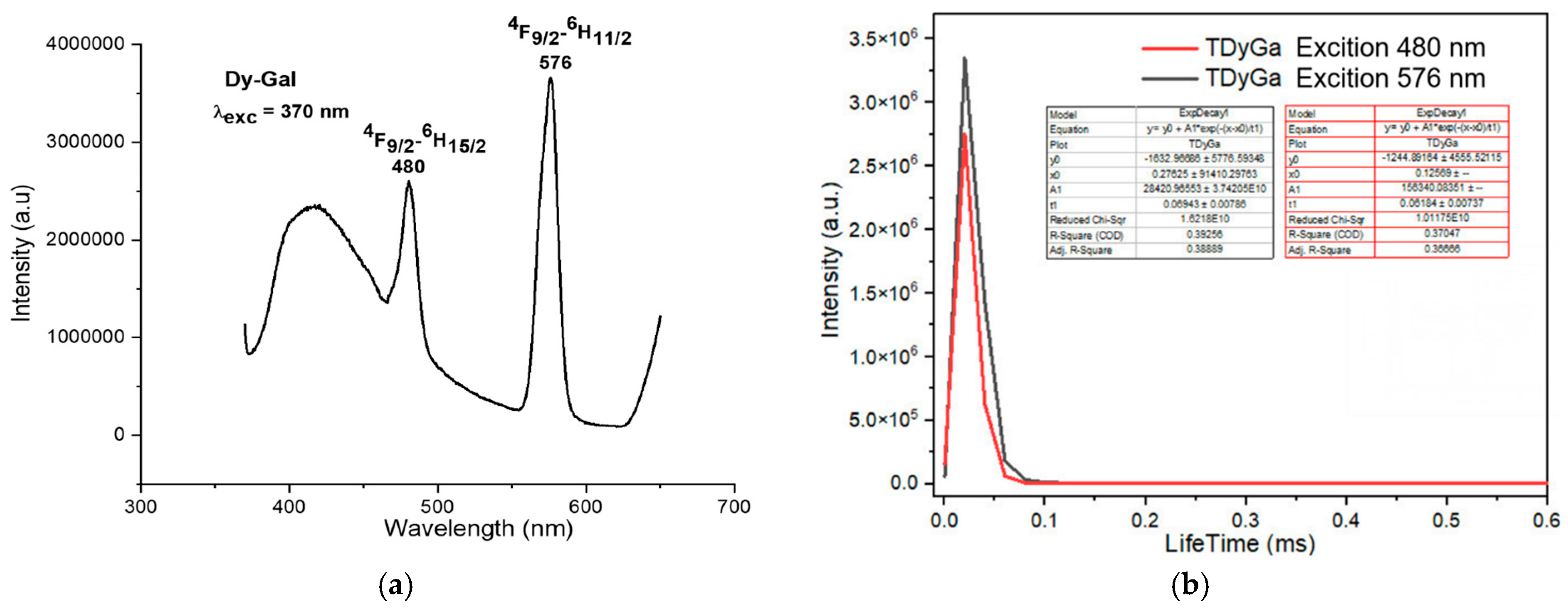Synthesis, Characterization, and Biological Activities of Rare Earth Metal Complexes with Gallic Acid
Abstract
1. Introduction
2. Results and Discussion
2.1. Character of Structure of Complexes
2.2. Fluorescence Character of Synthesized Complexes
2.3. Biological Activities of Metal Complexes with Gallic Acid
3. Materials and Methods
3.1. Synthesis of Ln(Gal)3 Complexes (Ln = Sm, Eu, Dy, and Yb)
3.2. Determination of Ln3+ Content (%) in the Complexes (Sm3+, Eu3+, Tb3+, and Dy3+)
3.3. The Infrared Spectroscopy of Complexes (Sm3+, Eu3+, Tb3+, and Dy3+)
3.4. Thermal Properties of Complexes (Sm3+, Eu3+, Tb3+, and Dy3+)
3.5. Mass Spectrometry of Complexes (Sm3+, Eu3+, Tb3+, and Dy3+)
3.6. Antibacterial Activity
3.7. Cytotoxicity Activity
3.8. Statistical Analysis
4. Conclusions
Supplementary Materials
Author Contributions
Funding
Institutional Review Board Statement
Informed Consent Statement
Data Availability Statement
Acknowledgments
Conflicts of Interest
References
- Zhang, L.; Li, B.; Yue, S.; Li, M.; Hong, Z.; Li, W. A terbium (III) complex with triphenylamine-functionalized ligand for organic electroluminescent device. J. Lumin. 2008, 128, 620–624. [Google Scholar] [CrossRef]
- Abdel Aziz, A.A.; El-Sayed, M.M.; Al-Mohammadi, A.R. Some novel rare earth metal ions complexes: Synthesis, characterization, luminescence and biocidal efficiency. Anal. Biochem. 2020, 598, 113645. [Google Scholar] [CrossRef] [PubMed]
- Pichaimani, P.; Lo, K.M.; Elango, K.P. Synthesis, crystal structures, luminescence properties and catalytic application of lanthanide (III) piperidine dithiocarbamate complexes. Polyhedron 2015, 93, 8–16. [Google Scholar] [CrossRef]
- Buldurun, K.; Turan, N.; Savcı, A.; Çolak, N. Synthesis, structural characterization and biological activities of metal (II) complexes with Schiff bases derived from 5-bromosalicylaldehyde: Ru(II) complexes transfer hydrogenation. J. Saudi Chem. Soc. 2019, 23, 205–214. [Google Scholar] [CrossRef]
- Shaygan, S.; Pasdar, H.; Foroughifar, N.; Davallo, M.; Motiee, F. Cobalt (II) complexes with Schiff base ligands derived from terephthalaldehyde and ortho-substituted anilines: Synthesis, characterization and antibacterial activity. Appl. Sci. 2018, 8, 385. [Google Scholar] [CrossRef]
- Taha, Z.A.; Ajlouni, A.M.; Al Momani, W.; Al-Ghzawi, A.A. Syntheses, characterization, biological activities and photophysical properties of lanthanides complexes with a tetradentate Schiff base ligand. Spectrochim. Acta Part A Mol. Biomol. Spectrosc. 2021, 81, 570–577. [Google Scholar] [CrossRef]
- Ajlouni, A.M.; Al Momani, W.; Al-Ghzawi, A.A.; Taha, Z.A. Synthesis, characterization, biological activities and luminescent properties of lanthanide complexes with [2-thiophenecarboxylic acid, 2-(2-pyridinylmethylene)hydrazide] Schiff bases ligand. J. Rare Earths 2016, 34, 986–993. [Google Scholar] [CrossRef]
- Kathiresan, S.; Annaraj, J.; Bhuvanesh, N.S. Cu (II) and Ni (II) Complexes of Anthracene-Affixed Schiff Base: A Conflict between Covalent and Stacking Interactions with DNA Bases. ChemistrySelect 2017, 2, 5475–5484. [Google Scholar] [CrossRef]
- Song, X.-Q.; Wang, Z.-G.; Wang, Y.; Huang, Y.-Y.; Sun, Y.-X.; Ouyang, Y.; Xie, C.-Z.; Xu, J.-Y. Syntheses, characterization, DNA/HSA binding ability and antitumor activities of a family of isostructural binuclear lanthanide complexes containing hydrazine Schiff base. J. Biomol. Struct. Dyn. 2020, 38, 733–743. [Google Scholar] [CrossRef]
- Kafi-Ahmadi, L.; Marjani, A.P. Mononuclear Schiff base complexes derived from 5-azophenylsalicylaldehyde with Co (ii), Ni (ii) ions: Synthesis, characterization, electrochemical study and antibacterial properties. S. Afr. J. Chem. 2019, 72, 101–107. [Google Scholar] [CrossRef]
- Kaczmarek, M.T.; Zabiszak, M.; Nowak, M.; Jastrzab, R. Lanthanides: Schiff base complexes, applications in cancer diagnosis, therapy, and antibacterial activity. Coord. Chem. Rev. 2018, 370, 42–54. [Google Scholar] [CrossRef]
- El-Gammal, O.A.; Mohamed, F.S.; Rezk, G.N.; El-Bindary, A.A. Structural characterization and biological activity of a new metal complexes based of Schiff base. J. Mol. Liq. 2021, 330, 115522. [Google Scholar] [CrossRef]
- Lis, T.; Kaczmarek, M.; Szydłowska, J. Synthesis and characterization of rare earth gallic acid complexes. Polyhedron 2000, 19, 1481–1488. [Google Scholar]
- Silva, R.T.C.; Silva-Caldeira, P.P.; Demarqui, F.; Lopes, C.D.; Albuquerque, S.; Pavan, F.R.; Pereira-Maia, E.C.; Diniz, R.; de Oliveira, A.; Rezende, C.; et al. Crystal structure and in vitro biological studies of a Pt(II) complex based on gallic acid and triphenylphosphine. Inorganica Chim. Acta 2024, 569, 122124. [Google Scholar] [CrossRef]
- Barcelo, J.; Guieb, M.; Ventura, A.; Nacino, A.; Pinasen, H.; Viernes, L.B.G.; Yodong, T.; Estrada, B.L.; Valdez, D.; Binwag, T. Antibacterial, Prooxidative and Genotoxic Activities of Gallic Acid and its Copper and Iron Complexes against Escherichia coli. Asia Pac. J. Multidiscip. Res. 2014, 6, 1–14. [Google Scholar]
- Gao, H.; Zhou, Y.; Chen, K.; Li, X. Synthesis of Tb4O7 complexed with reduced graphene oxide for Rhodamine-B absorption. Mater. Res. Bull. 2016, 77, 111–114. [Google Scholar] [CrossRef]
- Esra, Ö.; Nilgun, K. Synthesis and characterization of terbium oxide (III–IV) doped bismuth trioxide polymorphs. J. Chin. Adv. Mater. Soc. 2013, 2, 90–96. [Google Scholar]
- Sagar Babu, S.V.; Krishna Rao, K.; Ill Lee, Y. Synthesis, characterization, luminescence and DNA binding properties of Ln (III)-Schiff base family. J. Chil. Chem. Soc. 2017, 62, 3447–3453. [Google Scholar] [CrossRef]
- Li, H.; Jing, P.; Lu, J.; Xi, L.; Wang, Q.; Ding, L.; Wang, W.-M.; Song, Z. Multifunctional properties of {Cu II2 Ln III2} systems involving nitrogen-rich nitronyl nitroxide: Single-molecule magnet behavior, luminescence, magnetocaloric effects and heat capacity. Dalton Trans. 2021, 50, 2854–2863. [Google Scholar] [CrossRef]
- Li, H.; Jin, C.; Han, J.; Xi, L.; Song, Z. Tuning Nuclearity of Biradical-Ln Functional Compounds with Single-Molecule Magnet Behavior and Near-Infrared Luminescence. Cryst. Growth Des. 2022, 23, 612–619. [Google Scholar] [CrossRef]
- Li, H.; Jin, C.; Han, J.; Tang, J.; Han, X.; Song, Z. Near-infrared-II photothermal conversion and magnetic dynamic regulation in [Ln 3 Rad 2] aggregation by rigidity modification of nitronyl nitroxide. Inorg. Chem. Front. 2024, 11, 8421–8430. [Google Scholar] [CrossRef]
- Yang, X.; Wang, Y.; Wang, M.; Guo, F. The Role of Rare Earth Metal Ions in Antibacterial Activity: Mechanistic Insights. Int. J. Mol. Sci. 2020, 21, 6654. [Google Scholar] [CrossRef]
- Bansal, S.; Chhibber, T.; Singh, A.P.; Katare, O.P. Gallic Acid-Based Nanotherapeutics: A New Paradigm for Antimicrobial and Anticancer Applications. Molecules 2022, 27, 1194. [Google Scholar] [CrossRef]
- Borges, A.; Ferreira, C.; Saavedra, M.J.; Simões, M. Antibacterial Activity and Mode of Action of Ferulic and Gallic Acids Against Pathogenic Bacteria. Microb. Pathog. 2013, 66, 21–25. [Google Scholar] [CrossRef]
- Sharma, A.; Dube, A.; Singh, A.; Jain, S. Coordination Complexes of Polyphenols with Lanthanides: Emerging Antibacterial and Anticancer Agents. Coord. Chem. Rev. 2021, 429, 213615. [Google Scholar] [CrossRef]
- Auclair, C. Multimodal action of antitumor agents on DNA: The ellipticine series. Arch. Biochem. Biophys. 1987, 259, 1–14. [Google Scholar] [CrossRef]
- Bünzli, J.-C.G.; Eliseeva, S.V. Lanthanide luminescence for functional materials and bio-sciences. Chem. Sci. 2013, 4, 1939–1949. [Google Scholar] [CrossRef]
- Kostova, I.; Momekov, G. New lanthanide complexes of bioactive hydrazones: Synthesis, characterization, cytotoxicity and apoptosis induction in leukemia cells. Eur. J. Med. Chem. 2007, 42, 577–585. [Google Scholar] [CrossRef]
- Yang, C.S.; Wang, H. Cancer preventive activities of tea catechins. Molecules 2016, 21, 1679. [Google Scholar] [CrossRef]
- Sun, R.W.-Y.; Ma, D.-L.; Wong, E.L.-M.; Che, C.-M. Some uses of transition metal complexes as anti-cancer and anti-HIV agents. Dalton Trans. 2007, 43, 4884–4892. [Google Scholar] [CrossRef]
- Hadacek, F.; Greger, H. Testing of antifungal natural products: Methodologies, comparability of results and assay choice. Phytochem. Anal. 2000, 11, 137–147. [Google Scholar] [CrossRef]
- Trung, T.Q.; Hiep, H.P.; Khang, P. Chemical compositions of Litsea umbellata and inhibition activities. Open Chem. 2023, 21, 20220294. [Google Scholar] [CrossRef]
- Khang, P.; Hiep, H.; Trung, T. Two new compounds from leaves of Capparis dongvanensis (Sy, B.H. Quang & D.V. Hai) and inhibition activities. Open Chem. 2023, 21, 20220317. [Google Scholar] [CrossRef]







| Complex | Theoretical Ln3+ (%) | Experimental Ln3+ (%) |
|---|---|---|
| Sm(Gal)3·4H2O | 20.62 | 20.56 ± 0.41 |
| Eu(Gal)3·4H2O | 20.77 | 20.84 ± 0.35 |
| Tb(Gal)3·4H2O | 21.52 | 21.53 ± 0.32 |
| Dy(Gal)3·4H2O | 21.90 | 21.70 ± 0.25 |
| Entry | Complexes | v(COOH) | νas(COO−) | νs(COO−) | v(Ln-O) | v(OH) | vCH |
|---|---|---|---|---|---|---|---|
| 1 | HGal | 1695 | 1436 | 3261 | 2650 | ||
| 2 | Sm(Gal)3·4H2O | - | 1604 | 1421 | 555 | 3273 | 2987 |
| 3 | Eu(Gal)3·4H2O | 1604 | 1419 | 557 | 3277 | 2900 | |
| 4 | Tb(Gal)3·4H2O | 1604 | 1421 | 555 | 3273 | 2900 | |
| 5 | Dy(Gal)3·4H2O | 1604 | 1421 | 555 | 3273 | 2900 |
| Entry | Complex | Temperature at Which the Mass Loss Effect Occurs (°C) | Process | The Remaining Structure | Loss Weight (%) | |
|---|---|---|---|---|---|---|
| Theory | Experiment | |||||
| 1 | Sm(Gal)3·4H2O | 92 | Water removal | Sm(Gal)3 | 9.87 | 12.40 |
| 261 | Decomposition | Sm(Gal)2 | 23.18 | 20.02 | ||
| 330–650 | Decomposition | Sm2O3 | 43.08 | 44.86 | ||
| 2 | Eu(Gal)3·4H2O | 121 | Water removal | Eu(Gal)3 | 9.84 | 12.05 |
| 272 | Decomposition | Eu(Gal)2 | 23.12 | 27.25 | ||
| 272 | Decomposition | Eu2O3 | 42.96 | 34.34 | ||
| 330–650 | ||||||
| 3 | Tb(Gal)3·4H2O | 103 | Water removal | Tb(Gal)3 | 9.75 | 8.72 |
| 261 | Decomposition | Tb(Gal)2 | 22.89 | 24.30 | ||
| 261 | Decomposition | Tb4O7 | 42.03 | 37.28 | ||
| 320–640 | ||||||
| 4 | Dy(Gal)3·4H2O | 112 | Water removal | Dy(Gal)3 | 9.71 | 9.87 |
| 269 | Decomposition | Dy(Gal)2 | 22.77 | 22.29 | ||
| 320–650 | Decomposition | Dy2O3 | 42.37 | 35.56 | ||
| Entry | Complex | Fraction Ion | m/z | (%) |
|---|---|---|---|---|
| 1 | Sm(Gal)3·4H2O | [Sm2(Gal)3]+ | 808 | 37.03 |
| [Sm(Gal)3]+ | 657 | 100 | ||
| [Sm(Gal)2]+ | 488 | 27.77 | ||
| 2 | Eu(Gal)3·4H2O | [Eu2(Gal)3]+ | 811 | 30.00 |
| [Eu(Gal)3]+ | 659 | 100 | ||
| [Eu(Gal)2]+ | 490 | 75.00 | ||
| 3 | Tb(Gal)3·4H2O | [Tb2(Gal)3]+ | 825 | 35.18 |
| [Tb(Gal)3]+ | 666 | 100 | ||
| [Tb(Gal)2]+ | 497 | 61.11 | ||
| 4 | Dy(Gal)3·4H2O | [Dy2(Gal)3]+ | 832 | 71.11 |
| [Dy(Gal)3]+ | 669 | 100 | ||
| [Dy(Gal)2]+ | 500 | 51.11 |
| Samples | Con. | Escherichia coli (E.) | Staphylococcus aureus (SA) | Pseudomonas aeruginosa (PA) |
|---|---|---|---|---|
| Amoxicillin (control) | 50 µg/mL | 26.5 | 26.5 | 27 |
| Dy(Gal)3·4H2O | 100 µg/mL | 26 | 27 | 25 |
| 50 µg/mL | 26 | 19 | 19 | |
| 20 µg/mL | 20 | 19 | 14 | |
| Eu(Gal)3·4H2O | 100 µg/mL | 22 | 12 | 22 |
| 50 µg/mL | 21 | 0 | 20 | |
| 20 µg/mL | 18 | 0 | 20 | |
| Sm(Gal)3·4H2O | 100 µg/mL | 21 | 20 | 25 |
| 50 µg/mL | 17 | 0 | 18 | |
| 20 µg/mL | 12 | 0 | 0 | |
| Tb(Gal)3·4H2O | 100 µg/mL | 22 | 25 | 28 |
| 50 µg/mL | 18 | 20 | 21 | |
| 20 µg/mL | 0 | 18 | 20 |
| Complex | IC50 (µM) |
|---|---|
| Tb(Gal)3·4H2O | 11.3 ± 1.2 |
| Sm(Gal)3·4H2O | 13.7 ± 0.6 |
| Eu(Gal)3·4H2O | 15.4 ± 0.5 |
| Dy(Gal)3·4H2O | 34.4 ± 0.4 |
| Ellipticine | 0.55 ± 0.03 |
Disclaimer/Publisher’s Note: The statements, opinions and data contained in all publications are solely those of the individual author(s) and contributor(s) and not of MDPI and/or the editor(s). MDPI and/or the editor(s) disclaim responsibility for any injury to people or property resulting from any ideas, methods, instructions or products referred to in the content. |
© 2025 by the authors. Licensee MDPI, Basel, Switzerland. This article is an open access article distributed under the terms and conditions of the Creative Commons Attribution (CC BY) license (https://creativecommons.org/licenses/by/4.0/).
Share and Cite
Lan, N.T.H.; Hiep, H.P.; Trinh, D.C.; Khang, P.V. Synthesis, Characterization, and Biological Activities of Rare Earth Metal Complexes with Gallic Acid. Inorganics 2025, 13, 180. https://doi.org/10.3390/inorganics13060180
Lan NTH, Hiep HP, Trinh DC, Khang PV. Synthesis, Characterization, and Biological Activities of Rare Earth Metal Complexes with Gallic Acid. Inorganics. 2025; 13(6):180. https://doi.org/10.3390/inorganics13060180
Chicago/Turabian StyleLan, Nguyen Thi Hien, Hoang Phu Hiep, Dinh Cong Trinh, and Pham Van Khang. 2025. "Synthesis, Characterization, and Biological Activities of Rare Earth Metal Complexes with Gallic Acid" Inorganics 13, no. 6: 180. https://doi.org/10.3390/inorganics13060180
APA StyleLan, N. T. H., Hiep, H. P., Trinh, D. C., & Khang, P. V. (2025). Synthesis, Characterization, and Biological Activities of Rare Earth Metal Complexes with Gallic Acid. Inorganics, 13(6), 180. https://doi.org/10.3390/inorganics13060180






